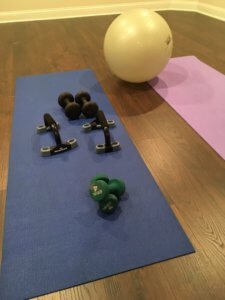“I’d rather die in a burning building than exercise.”
So said the aunt of one of my friends.
A long time ago.
The impact of that statement hit me full force; I’ve never forgotten it.
Of course she didn’t REALLY mean “die in a burning building”; but she made her point.
I do have to give her credit for her honesty. I mean, if you hate it, you hate it. And let’s face it, she’s not the first (nor the last) to feel such disdain for working up a sweat.
For those of us who would rather exercise than do pretty much anything else, it’s tough to comprehend such vehement disillusionment.
But this post isn’t about why someone would avoid exercise like the plaque, rather, it’s a gentle reminder of how exercise can benefit us in the breast cancer community. And, to encourage you to find a little space in your heart, mind and day to embrace movement for all the goodness it can do – even if you HATE it.
One can hope, right?
Let’s Get To It!

Just this week alone, two studies linking exercise and physical activity to improved outcomes appeared in my news feed, courtesy of ASCO – American Society of Clinical Oncology. On February 16-17, 2018 ASCO, The American Academy of Family Physicians, and the American College of Physicians will co-sponsor the “Cancer Survivorship Symposium”. Lots of good stuff coming out in advance of (and during!) this meeting; allow me share some of it here.
Study #1
Four-year effects of physical exercise during adjuvant treatment on fatigue and physical activity in breast and colon cancer patients. May, AM et al. Abstract 99
“In the past, patients were often told to rest and reduce their physical activity during treatment, but we now know that exercise is both safe and highly beneficial. As this study shows, exercising during cancer treatment can also make a significant impact on survivors’ health and quality of life over the long term. . .” ASCO Expert Timothy Gilligan, MD, MSc, FASCO
Cancer-related fatigue is a reality and can be long-lasting, well past the completion of treatment. Yet time and again, studies show that exercise can positively impact fatigue, as I addressed here.
As a result of the progress in care and treatment, more people are surviving breast cancer than ever before, yet poor quality of life can have negative consequences for survivorship. Regaining some semblance of post-treatment “normal” physical ability is critical. Exercise DURING treatment is worth considering as a way to encourage this transition. Get your doctor’s ok, then give it a try.
Study #2
Effects of a lymphedema prevention intervention on range of motion among women receiving lymph node dissection for breast cancer treatment (Alliance) CALGB 70305.
“Knowing that exercise after surgery can help women with breast cancer quickly restore their full range of arm motion is an important step forward in their care. This study shows how important it is for women to receive physical therapy after surgery to remove lymphatic tissue.” ASCO Expert Timothy Gilligan, MD, MSc, FASCO.
Again, this speaks to quality of life post-treatment (yes, surgery is considered treatment). I know many women who experience limited range of motion (ROM) as a result of surgical intervention. Moving vs. holding the arm immobile, as well as engaging in exercises that increase flexibility help improve ROM, yet discomfort, tightness and pain may discourage someone from even attempting.
If you’re hesitant to try this on your own – and you may well be; it can be challenging to determine when pain or discomfort is considered a “normal” part of the healing process – ask your doctor for a referral to either a physical therapist or a fitness professional trained and specializing in oncology exercise.
Even if you feel intimidated by the idea of adding physical activity to your daily routine, I hope these encouraging studies give you incentive to at least CONSIDER starting to do something.
Something small, easy, and tolerable. We’re not talking running marathons or powerlifting for heaven’s sake. And no burning buildings are involved, anywhere.
You can do this.
Trust me. It’s life-changing.
Get My “NUTRITION & FITNESS Jumpstart Worksheet” FREE!Sources
- Four-year effects of physical exercise during adjuvant treatment on fatigue and physical activity in breast and colon cancer patients.
- Effects of a lymphedema prevention intervention on range of motion among women receiving lymph node dissection for breast cancer treatment (Alliance) CALGB 70305.

